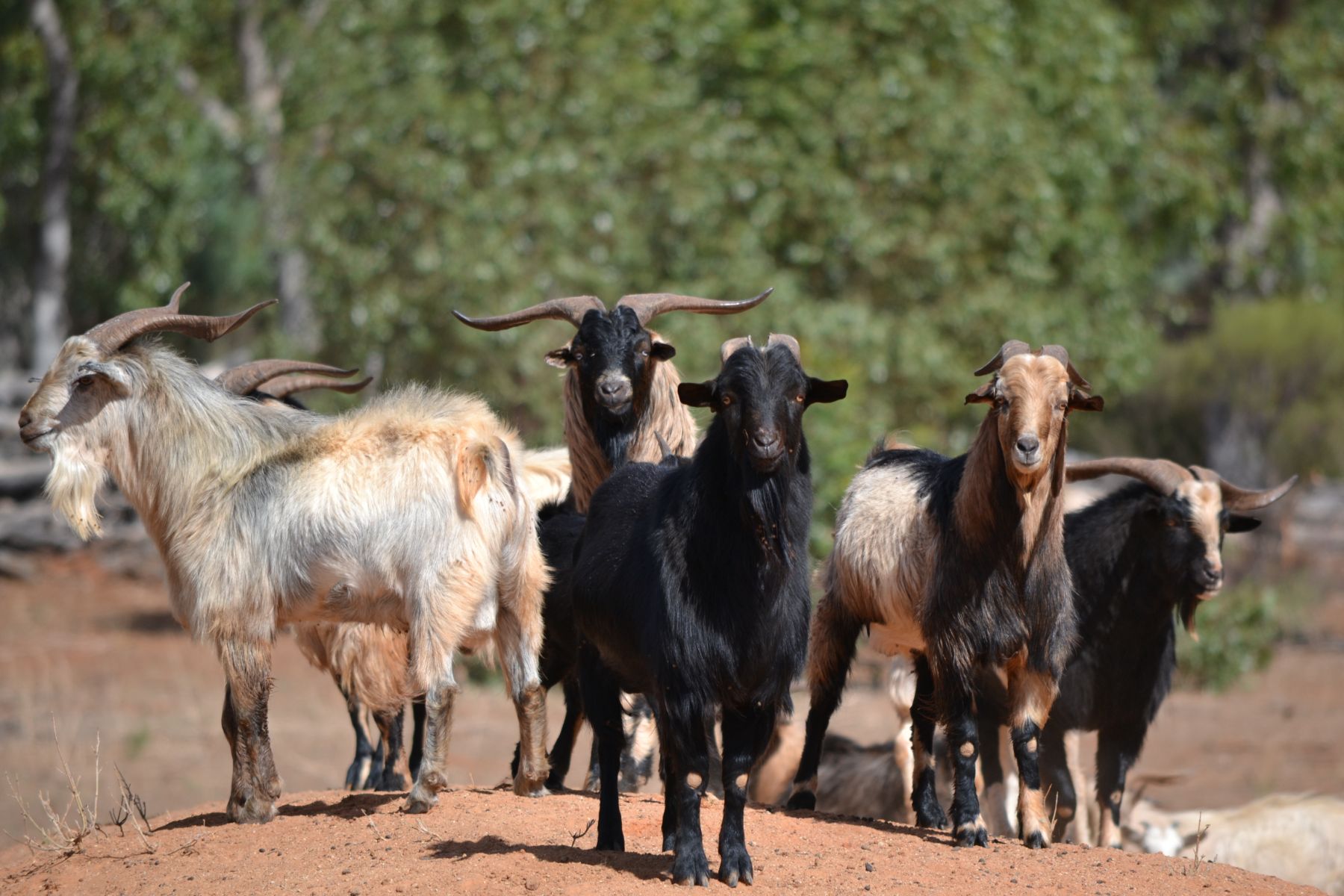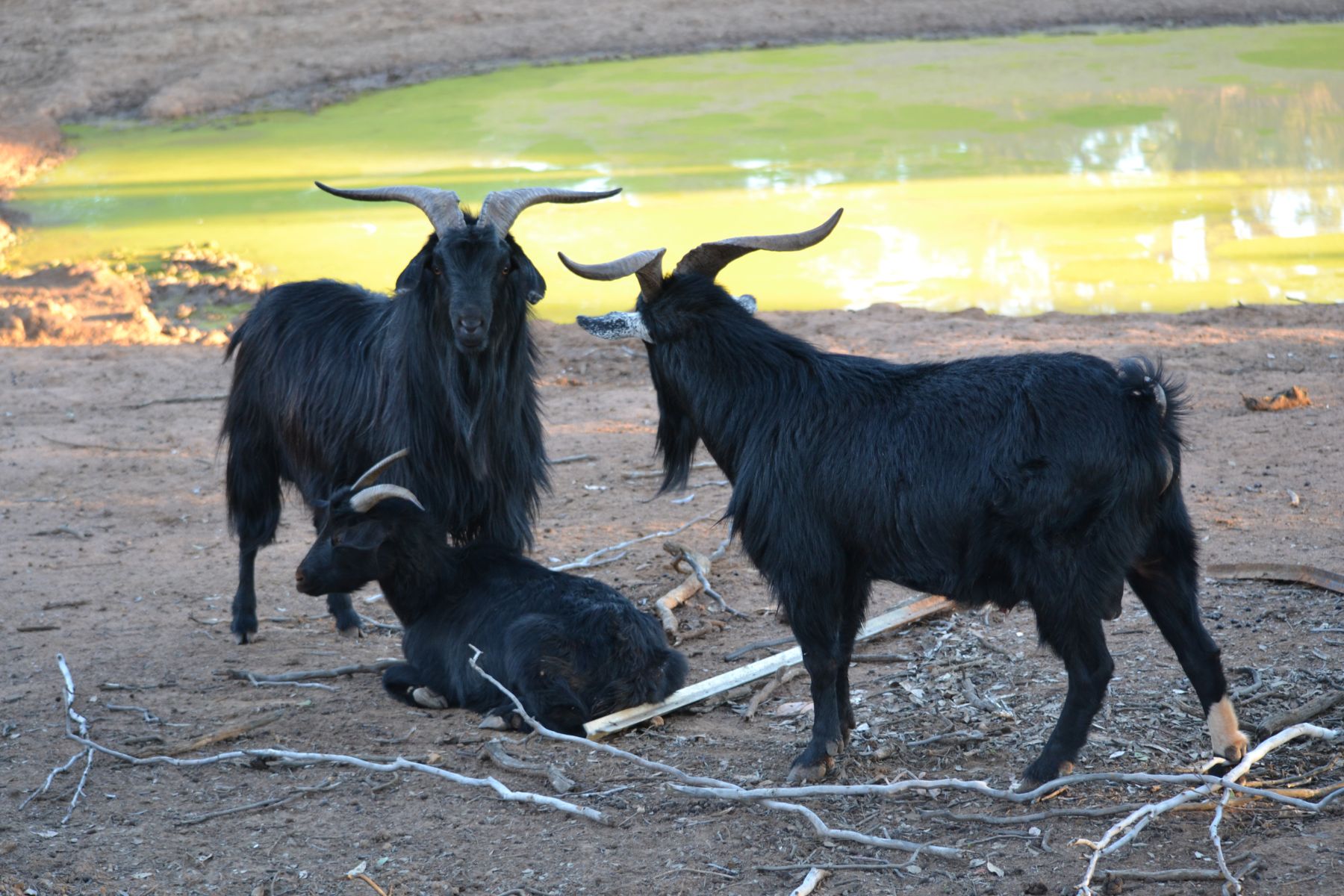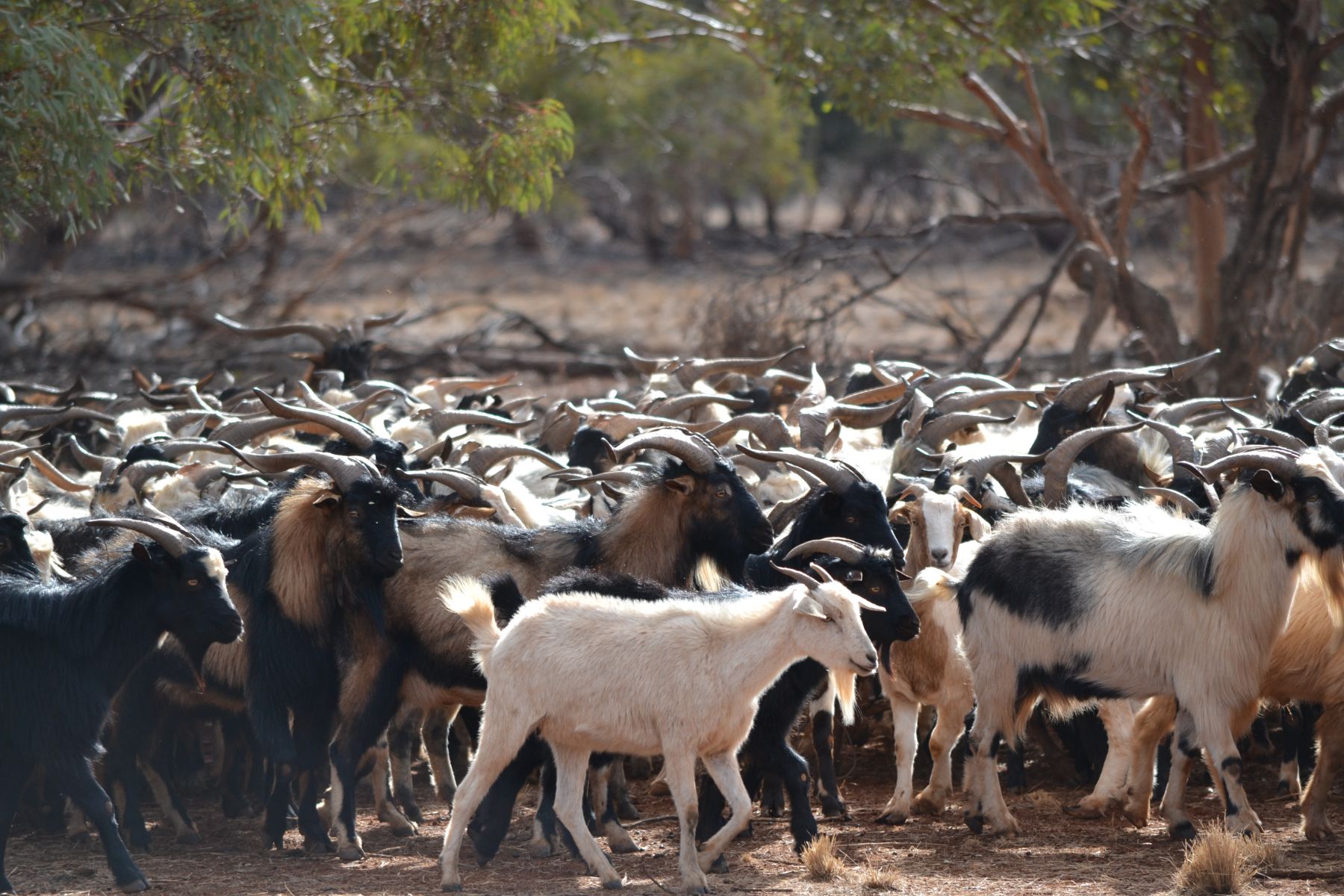Goat (feral or wild)
Common name: Goat (feral or wild)
Scientific name: Capra hircus
Origin: Asia
Animal status
Goats (feral or wild) are declared as established pest animals in the state of Victoria under the Catchment and Land Protection Act 1994 (CaLP Act)
Read more about the classification of invasive animals in Victoria.
Populations
History of spread
Feral goats have been present in Australia since early European settlement. Wild populations have become established because of accidental escape or deliberate release of various breeds of domestic goats. Early populations were initially concentrated near settlement areas, but they have since spread across 35% of Australia and occur on many offshore islands.
Goats were introduced to many areas by early settlers, miners and railway construction gangs for meat and milk.
Cashmere and Angora goats were also introduced to Australia in the mid-1800s for the fibre industry. When this industry collapsed in the 1920s, many goats were abandoned in preference for wool, which added to the feral population.
The mixed origins of Australia’s feral goats are reflected in the genetic diversity seen in wild populations.
The greatest numbers of feral goats occur in the arid and semi-arid pastoral regions of Queensland, New South Wales, South Australia and Western Australia. However, it appears their numbers are increasing in parts of the Great Dividing Range.
Distribution in Victoria
There is little information available regarding feral goat distribution and density in Victoria, but anecdotal information suggests their largest populations occur where large tracts of forested or semi-arid areas offer protection from predators. Feral goats have also been sighted in many state and regional parks and forests throughout Victoria.
Factors that influence feral goat distribution include food, water and shelter. Occurrence of parasites and diseases, and predators such as wild dogs are also influential.
Animal biology
Appearance
There are over 300 distinct breeds of goat throughout the world, but the Australian feral goat population is thought to consist of a mix of Angora, Cashmere, Anglo-Nubian, British Alpine, Saanen and Toggenburg breeds.
Both male and female goats have distinctive curved or corkscrew shaped horns, although some may be hornless. Their coats vary widely depending on breed and so does their hair type with it being either short, long, curled, silky or coarse. Goats may also have wattles (hanging fleshy lobes) on the neck and beards.
An adult male goat is called a buck, the female is called a doe and juveniles are referred to as kids. Adult males may also be referred to as 'billies' and females as a 'nannies'. Adult goats weigh between 40 and 60 kg while kids weigh about 2.6 kg at birth. Male kids are heavier than females and this is a difference that they retain throughout their lives.
Behaviour
Feral goats are highly social animals that form family units typically consisting of an adult female goat and her recent offspring. Family social units associate together to form what is known as a herd.
Male kids eventually leave their mothers to form 'bachelor' herds with other similar aged males. Feral goat bachelor herds overlap with the female's home range during breeding periods but may range over much larger areas for the rest of the year. Feral goat home ranges can vary from one square kilometre to 600 square kilometres depending on resource availability.
Female goats leave the group to give birth in a protected place such as a rock overhang cave or dense vegetation. Goat kids can follow their mothers soon after birth, but many remain hidden for the first few days and are only visited by their mothers for feeding.
Feral goats are most active during the day and rest at night in regular camp sites. Herd dynamics varies depending on seasonal changes, birth rates and the movements of the male bachelor herds. Feral goats tend to use high or difficult-to-access areas as their night-time camp sites to minimise the risk of predation.
Feral goats often use sense of smell rather than sight to find food and detect predators. Therefore, they prefer to graze facing into the wind to detect scent.
Goats are reliant on access to water and their home range will revolve around it. The frequency at which goats drink is influenced by environmental conditions. Generally, a herd of feral goats is led by a dominant male, and he shares leadership with a dominant female who will usually outlast several dominant males throughout her time.
Adult male goats display dominance through a variety of contact and non-contact methods. Non-contact threats include staring, facing a rival with the chin down and horns forward, rushing or rearing. Encounters where physical contact occurs include pushing, head butting, engaging horns and rearing up and clashing. Other signs of dominance include horn size, physical condition and scent.
Feral goats are highly social animals that have complex systems of communication including smell, sight and sound. Alarm behaviour in feral goats is highly developed, making them difficult to drive/muster. When a female goat detects danger, she will stand rigid with ears towards the potential danger. Kids respond by running to the relative safety of the female. Female goats may also snort loudly and repeatedly to alert nearby goats. Depending on the threat, the group may flee, move away slowly, or return to their previous activities.
Diet
Feral goats are opportunistic browsers that generally select the highest quality foods available. They will eat:
- grass
- leaves
- twigs
- bark
- flowers
- fruit
- roots
- plant litter
- seeds
- fungi.
Despite their tendency to select high-quality foods, feral goats can eat most plant species in Australia, including many that are toxic, spiny or bitter.
An average-sized goat requires between 2 and 4.5 litres of water per day, depending on temperature. Despite this, some goats in cooler and wetter climates can obtain most of their water from their food, meaning can survive in some areas with limited permanent fresh water.
Preferred habitat
Feral goats can survive where food, water and protection from predators is available. In Victoria, feral goats tend to occur in the semi-arid environments of the north-west and the mountainous areas of the Grampians, Alpine and East Gippsland regions.
Predators
Wild dogs and dingoes are the most significant predators of feral goats in Australia. Feral pigs foxes and large eagles may also prey upon feral goats, particularly goat kids.
Diseases and parasites
Feral goats are susceptible to several endemic diseases currently found in Australia, including:
- Johne's Disease
- Q fever
- tetanus
- leptospirosis
- hydatids
- pulpy kidney
- blackleg
- various parasitic worms of the gastrointestinal tract.
Feral goats are also susceptible to many exotic livestock diseases that are not present in Australia, including:
- foot-and-mouth disease
- scrapie
- rinderpest
- Rift Valley fever
- rabies
- Blue tongue.
Reproduction
Feral goats can breed all year round, but breeding tends to peak during autumn.
Feral goat breeding is influenced by environmental factors including drought, population dynamics, food and water availability. Despite variations in breeding seasons, all sexually mature female goats commonly come into season at about the same time.
Feral goats have a higher proportion of females than males, so population growth can be high. It is generally accepted that a population has the potential to double in size every 1.6 years, without human influence or control.
Female goats are sexually mature from 6 months of age and can produce young twice a year, with a gestation period of only 150 days. Twins and triplets are relatively common among domestic and in feral goat populations, but most feral goats tend to have singles or twins.
Dispersal
Dispersal of feral goats depends on availability of food, water and shelter. Feral goats prefer to maintain a small home range and traditional camp sites where possible, but they will disperse when food and water becomes scarce. Young female goats will stay with their family group throughout their lives, while males will leave these groups at puberty and join bachelor groups.
From day to day, large herds may will separate into smaller subgroups during the day and re-unite at night at common camp sites.
Impact
Impact on ecosystems and waterways
Feral goats cause considerable environmental impacts through:
- soil damage
- over grazing
- browsing.
As a selective browser, feral goats can drastically impact specific plant communities over a relatively short period.
Goats are also capable of climbing trees where branches and trunks are on suitable angles, enabling them to graze much higher than kangaroos or sheep. Even when adult trees can survive, goats will destroy seedlings affecting the rate of recruitment and limiting the survival of that plant community.
Feral goats compete with many animals for resources. Goat dung around water ways, together with goat carcasses that have fallen into the water, is likely to affect water quality.
Competition and land degradation by feral goats is listed as a key threatening process under the Commonwealth Environment Protection and Biodiversity Conservation Act 1999 (EPBC Act).
Agricultural and economic impacts
Feral goats are a major agricultural pest throughout Australia.
Economic losses can be categorised into 4 areas of cost:
- Costs to primary production
- Costs associated with exotic disease management
- Costs from land degradation
- Costs for routine feral goat management
In other Australian states, some costs can be recouped by mustering and selling feral goats. Due to lower numbers and difficult terrain, it’s generally not practised in Victoria.
The monetary value of economic losses in Victoria is unknown. However, the cost to Australia is estimated to be around $25 million per annum.
While feral goats are found mostly on public land in Victoria, they are also found on private property in some areas. Feral goats and domestic livestock have overlapping diets and habitats which can cause competition with domestic livestock for food, water and shelter. Feral goats can also out-compete and outlast sheep and kangaroos in time of drought.
Primary producers who own domestic goats may incur costs by having to prevent male feral goats from mating with their females. Foresters also incur costs to production caused by goat damage to their seedlings.
Feral goats are known to be susceptible to several diseases of livestock including Ovine Johne's Disease, foot-and-mouth, rinderpest, rabies and blue tongue. Unchecked wild herds could potentially play a major role in the spread of exotic disease if they were introduced into Australia.
Management
Recommended control measures for feral goats include:
- trapping
- shooting
- mustering
- exclusion fencing.
The department recommends that integrated pest management using all suitable control measures should be implemented in a coordinated manner at a landscape scale.
Read more about management and control of feral goats.
Further reading
- Fleming, P and Tracey, J 2003, Methods for Determining Feral Goat Abundance in Rugged Terrain, Vertebrate Pest Research Unit, NSW Agriculture.
- Forsyth D. M., Duncan R. P., Bomford M. and Moore, G. 2004 Climatic suitability, life history traits, introduction effort and the establishment and spread of introduced mammals in Australia. Google Scholar listing. Accessed 22 April 2022
- Department of the Environment, Water, Heritage and the Arts (DEWHA) (2008). Background document for the threat abatement plan for competition and land degradation by unmanaged goats, DEWHA, Canberra
- McGregor, B 2007, An Introduction to Reproduction Management of Fibre and Meat Goats, Department of Primary Industries, Attwood. Accessed online 22 April 2022
- Parkes, J, Henzell, R and Pickles, G 1996, Managing Vertebrate Pests: Feral Goats, Bureau of Resources, Sciences and Australian Nature Conservation Agency, Australian Government Publishing Services, Canberra. Accessed online 22 April 2022
- Parks Victoria Annual reports on the Victorian Government Library Service website. Accessed online 22 April 2022
- Parkes, J, Henzell, R and Pickles, G 1996, Managing Vertebrate Pests: Feral Goats, Bureau of Resources, Sciences and Australian Nature Conservation Agency, Australian Government Publishing Services, Canberra. Accessed online 22 April 2022
Image credits
Figures 1 to 4 courtesy of Jason Wishart